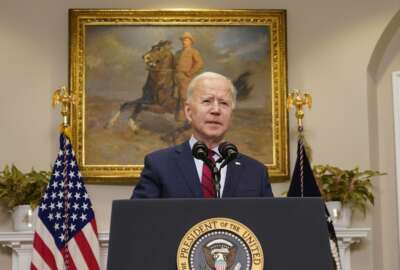
Union leaders say staffing shortages are stretching their agencies thin
This time last year, local leaders at the American Federation of Government Employees were scrambling to resolve multiple crises. Now, they’re highlighting...
This time during last year’s Public Service Recognition Week, many local union leaders were in crisis mode, scrambling to secure personal protective equipment for their coworkers, raise safety concerns with agency management and navigate the still early days of a global pandemic.
Some of those concerns have subsided somewhat today, and local leaders at the American Federation of Government Employees said they see a noticeable difference in the tone from the top.
When National President Everett Kelley speaks with agency leaders now, many mention they have marching orders from the White House to comply with executive orders from the administration and establish better working relationships with federal employee unions, AFGE told reporters Monday.
Still, AFGE local leaders are trying to raise alarm bells about a challenge they said has persisted throughout administrations and before the pandemic.
“Things haven’t changed that much, but what has changed is we have a new president who is allowing us to sit at the table and who is allowing us to have a voice on some of these subjects,” said Geddes Scott, president of an AFGE local that represents the workforce at the Veterans Affairs community living center in Queens, New York. “One of the major subjects we have brought up prior to the pandemic is the vacancies and its impact on care.”
Geddes said he usually has 550 people in his bargaining unit, but 110 positions are vacant.
VA has long struggled to fill vacancies for years, though the department has said it’s managed to recruit more people during the pandemic. The Veterans Health Administration listed 37,127 funded and unfunded vacancies in its most recent public report to Congress. Those reports are required under the VA MISSION Act by Congress.
Other agencies struggle to fill vacancies as well.
Joe Shuker, president of an AFGE local representing transportation security officers in Philadelphia, said staffing is a challenge at the Transportation Security Administration, which is trying to hire 6,000 new officers for the summer travel season.
“We have such turnover here that we can’t keep anyone,” he said. “That’s pretty much our issue. With our staffing numbers we just can’t keep up.”
Shuker said most TSOs, tired of working early and long hours, often leave after three-to-seven years with the agency. He works with about 650-to-700 TSOs in Philadelphia, and about 200 employees leave each year.
“They’re overworked because we’re understaffed,” he said.
The Bureau of Prisons is facing a similar situation, said Jonathan Zumkehr, president of the AFGE local representing correctional officers at the prison in Thomson, Illinois.
Zumkehr said his facility is short 110 correctional officers, despite efforts by the agency to hire more personnel. BOP correctional officers are taking on more than 2,000 occurrences of overtime each month to compensate for staffing shortages, he said.
At FEMA, the agency is juggling response efforts for 960 declared disasters around the country, at least one in each state.
“My people have absolutely worked their butts off this year,” said Steve Reaves, president of a national AFGE local representing FEMA employees. “It’s been a moving target. We’ve been put in charge of things we’re not historically used to being put in charge of: COVID, the fires, the hurricanes, we still deal with all of that. This year we had the Capitol riots, too.”
Reaves believes the Office of Personnel Management should conduct a new manpower management survey of FEMA, which he said would offer more clarity on staffing levels necessary to tackle a mission that seems to broaden each year.
Some FEMA personnel are also helping the Department of Health and Human Services with response efforts at the southern border.
“It’s not uncommon to have two or three jobs at FEMA,” Reaves said. “You have a deployed job, you have a job that you do steady state, and then you’re probably doing somebody else’s job because they’re gone. It’s only a matter time before that negatively affects our customer service and the impact we have on our country.”
AFGE local leaders see low pay as the primary reason for staffing challenges at agencies like TSA and BOP.
“We have to be attractive,” Kelley said. “We have to be like what most companies have done over the last few years. They understand that in order to attract the best and the brightest, that means that they have to make sure that their pay and benefits surpasses everyone else. That’s what private corporations have done. They have been a master at that. When the federal government understands that and begins to pay adequately and have the very best benefits there is to offer, you’re going to see us get the best employees, and they’ll stay with us.”
The public’s perception of federal employees doesn’t help either, AFGE said.
“We got a lot of love during the shutdown,” Shuker, the TSA local union president, said. “Our guys were coming to work not getting paid. The public knew that. They appreciated us being there because they still wanted to fly, and we were getting them through safely. That [was] short-lived.”
Events like Public Service Recognition Week may help, but AFGE local leaders said the federal workforce deserves appreciation every week of the year.
“No one appreciates the garbage men until the garbage isn’t picked up,” Scott said. “No one appreciates a government employee until things start to happen, when FEMA’s not there, when the VA nurse is not at the bedside, when TSA isn’t there checking [and] when DoD isn’t there to protect us.”
Copyright © 2025 Federal News Network. All rights reserved. This website is not intended for users located within the European Economic Area.
Nicole Ogrysko is a reporter for Federal News Network focusing on the federal workforce and federal pay and benefits.
Follow @nogryskoWFED
Related Stories





